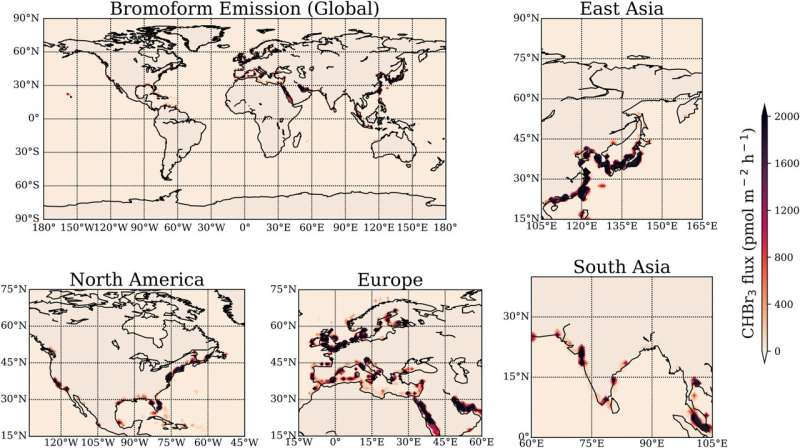May 22, 2023 report
This article has been reviewed according to Science X's editorial process and policies. Editors have highlighted the following attributes while ensuring the content's credibility:
fact-checked
peer-reviewed publication
trusted source
proofread
More anthropogenic bromoform found in lower atmosphere than thought

A team of atmospheric scientists and oceanologists from the University of Saskatchewan, GEOMAR Helmholtz Center for Ocean Research Kiel and Utrecht University, has found that there is more man-made bromoform (CHBr3) in the lower atmosphere than previously thought. In their study, reported in the journal Geophysical Research Letters, the group used existing data to create models depicting amounts of bromoform in the atmosphere.
Prior research has shown that phytoplankton and algae produce bromoform, a brominated organic solvent that seeps into the lower atmosphere where it decomposes, releasing bromide. Bromide has been found to rise into the stratosphere, where it degrades the ozone layer. Prior research has also found that human-produced bromoform does much the same, but because of its short lifetime, it was believed not to pose a risk to the ozone.
For that reason, it was not included in the 1987 Montreal Protocol, an international agreement that banned emissions of chemicals that harm the ozone layer, most particularly hydrofluorocarbons. And while it has been acknowledged that banning such chemicals had a dramatic positive impact on the ozone layer, more recent research has shown that more needs to be done. In this new effort, the research team suggests that bromoform may need to be banned, as well.
The researchers collected existing data regarding emissions of bromoform from power plants, ship ballast and desalination plants. They used that data to create multiple simulations to show the impact of such emissions on the ozone layer. The team found that power plants produce by far the most: approximately 10% to 25.9% of all man-made bromoform.
The research team then compared their models with samples collected from airplanes in the past few years. The simulations agreed with the field observations. They note that both findings show that man-made bromoform emissions are higher than previously believed and that they might explain why the ozone layer has not yet fully recovered after initiation of the Montreal Protocol.
More information: Yue Jia et al, Anthropogenic Bromoform at the Extratropical Tropopause, Geophysical Research Letters (2023). DOI: 10.1029/2023GL102894
Journal information: Geophysical Research Letters
© 2023 Science X Network




















